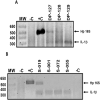Helicobacter pylori prevalence in healthy Mexican children: comparison between two non-invasive methods
- PMID: 34249489
- PMCID: PMC8247697
- DOI: 10.7717/peerj.11546
Helicobacter pylori prevalence in healthy Mexican children: comparison between two non-invasive methods
Abstract
Background: Helicobacter pylori detection in asymptomatic children with suspected infection or with symptoms that suggest gastric pathology is problematic, since most of the methods depend on the endoscopic study, an invasive and expensive method. Non-invasive methods can be a feasible alternative but must be validated. The purpose of this study was to evaluate the concordance between H. pylori DNA detection in saliva and dental plaque by PCR, with antigen detection in stool by immunochromatography, among asymptomatic children in the state of Guerrero, Mexico.
Methods: Dental plaque, saliva, and stool samples were obtained from 171 children between 6 and 12 years old. H. pylori detection in saliva and dental plaque was performed by PCR using specific primers for the 16S rRNA gene, while the detection in stool samples was performed by immunochromatography using the CerTest kit.
Results: We found an overall H. pylori prevalence of 59.6% (102/171). Of the H. pylori positive children 18% (20/111) were positive in saliva samples, 28.1% (34/121) in dental plaque samples, and 50.4% (71/141) in stool samples. A higher prevalence was found in girls (64.7%, p = 0.002). Although some of the children declared some dyspeptic symptoms, these were no related to H. pylori. In conclusion, we found a high prevalence of H. pylori in asymptomatic children and the highest proportion was detected by stool antigen test, which was the most feasible method to detect H. pylori infection.
Keywords: Children; H. pylori; Mexico; Non-invasive methods; Prevalence.
© 2021 Martínez-Santos et al.
Conflict of interest statement
The authors declare that they have no competing interests.
Figures



References
-
- Bermúdez Díaz L, Ernesto Torres Domínguez L, Rodríguez González BL. Métodos para la detección de la infección por Helicobacter pylori. Revista Cubana de Medicina. 2009;48
-
- Bosques-Padilla FJ, Remes-Troche JM, Gonzalez-Huezo MS, Perez-Perez G, Torres-Lopez J, Abdo-Francis JM, Bielsa-Fernandez MV, Camargo MC, Esquivel-Ayanegui F, Garza-Gonzalez E, Hernandez-Guerrero AI, Herrera-Goepfert R, Huerta-Iga FM, Leal-Herrera Y, Lopez-Colombo A, Ortiz-Olvera NX, Riquelme-Perez A, Sampieri CL, Uscanga-Dominguez LF, Velarde-Ruiz Velasco JA. The fourth Mexican consensus on Helicobacter pylori. Revista de Gastroenterología de México. 2018;83(3):325–341. - PubMed
-
- Campbell DI, Thomas JE. Helicobacter pylori infection in paediatric practice. Archives of Disease in Childhood - Education & Practice Edition. 2005;90(2):ep25–ep30.
LinkOut - more resources
Full Text Sources

